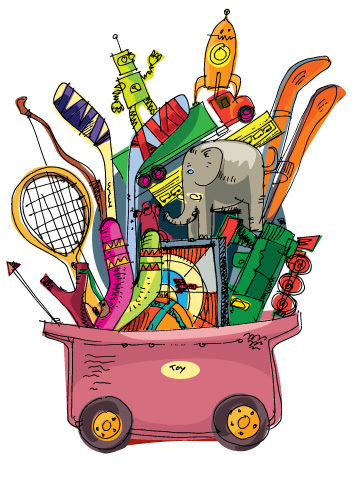In our Early Childhood Family Education class this term, we’ve been talking about the effects that a child’s environment has on his or her development and behavior—and more specifically, the fact that most American children have way more toys than they even know what to do with.
Supposedly, the average U.S. child consumes more than 70 toys a year. What happens when kids have that many toys?
- For one thing, they tend to be so overwhelmed that they don’t play with any of them—there’s simply too much to choose from.
- They have very little respect for or appreciation of any of their toys (or, for that matter, any of the other material things in the house).
- And they tend to develop certain expectations, habits, or attitudes about the availability of material goods and their entitlement to those goods.
Check, check, and check.
Plus, having so many toys around creates a cluttered house that drives the parents bananas. One of the more amazing (negative) things about parenting is how much time I spend just managing the kids’ stuff. And when it’s stuff that they don’t really play with, it’s even more frustrating.
The toy purge challenge
Since most families think that they don’t have a toy problem, ECFE suggests this exercise: Imagine putting all your toys in a pile in your living room. How much space do they occupy? For most families, it would be very difficult to fit everything onto a 9×13 area rug.
Intrigued by this question, last Saturday I decided to do a real-world experiment. I announced that for their chore, the kids had to bring every single toy in the house to the 9×13 area rug in our living room. They responded with surprising enthusiasm. (We’re also planning a garage sale, so this had a practical aspect to it, too.) After more than an hour and a half of hauling toys into the living room, here was the result:
As you can see, the toys spilled off of the rug onto the couches and the rest of the floor…
…plus onto the dining room table, and the writing desk (background).
Here’s another perspective on the main pile. Notice the empty shelves in the playroom.
The resulting mess did not include any of their many outdoor toys, nor the big doll house in the girls’ bedroom (too big to move downstairs for this exercise), nor the art supplies and knick-knacks inside the desk, nor four bookcases full of children’s books. Plus, we kept finding toys around the house even after this was taken.
How to decide what to keep and what to toss
What to do? Well, according to the book that we’re drawing from in ECFE, our goal should be to get rid of three-fourths of those toys. Here’s some criteria they suggest for culling toys:
- If it’s broken or missing pieces, it goes in the trash. No, you’re never going to get around to fixing it or replacing the missing pieces—that’s just a fantasy. So get rid of it now rather than years from now.
- If it’s no longer developmentally appropriate (e.g., baby toys in a household where the youngest child is five), get rid of it.
- If it’s a toy that your child observes rather than actively plays with (think of all those toys that make noise and light up), get rid of it.
- If it’s offensive or destructive, get rid of it (Mighty Morphin’ Power Rangers are the bane of every kindergarten classroom).
- If it’s designed to offer a very narrow range of play possibilities, get rid of it. Wooden blocks and LEGOS and dolls have a wide range of play possibilities; that Magic Eight Ball and paint-by-number set has a very narrow range of play possibilities.
- Still got too many toys? Divide the pile in half. Throw away one half. Divide the remaining pile in half again. Give away one half. Divide the resulting pile in half again. Put one half in storage.
It sounds radical, but the research—and anecdotes I’ve heard from other parents—support the idea that kids do better with a few high quality toys.
Yes, they’ll want more—that’s human nature, to always want more. We’re born with that God-sized hole, right? But the truth is that nothing will ever fill that hole in a permanent, satisfying way (except God, of course). Not getting everything they want helps children develop self-discipline, and helps to retard the illusion that happiness lies in having rather than being.
What makes purging so hard?
I have to admit that this is very, very hard for me. Harder for me than for the kids, actually. With some of the toys, it’s that in my head I’m still living in that moment of happiness and delight that each child had when he or she first received the toy. Getting rid of it feels like taking it out of the hands of that happy child.
But what I am finding is that, more often than not, the kids are pretty sanguine about getting rid of toys that they absolutely cherished at one point.
The other difficult layer on this is the waste. I think of how much money we (and our friends and relatives) spent on these toys. Our pile of toys probably cost something like $3,000 – $7,000 originally. It makes me wince to throw away a $20 toy, even if it’s broken in a way that renders it unusable (and it’s unrepairable, to boot).
I also think of the many children out there in the world who would find great pleasure even in a broken toy. I think of the kids in our friends’ orphanage in Paraguay, for example. And then there’s the environmental aspect: so much of what they have is cheap plastic you-know-what that gets played with for a few moments before being tossed into a landfill (McDonald’s toy, anyone?).
Kids don’t “need” store-bought toys
Because here’s a nasty little secret that no one from a wealthy country wants to admit: Children—especially children age three and under—don’t actually need store-bought toys in order to be happy, or to develop normally. Children age three and under are much more interested in “playing” with whatever “toys” or “tools” they see the adults around them using. It’s a survival instinct: the sooner little cavepeople learned to do what the adults did, the better their chances of surviving. Check it out with your own toddler. What keeps his attention the longest—your phone, or the latest light-up toy? Her toy drums, or your pots and pans? Play dough, or running water in the sink?
The best proof that our kids don’t need store-bought toys is the fact that the majority of children throughout history, and even around the world today, didn’t or don’t have them. And guess what? They made up ways to play—and their own toys!—using what they had at hand. Personally, I find it hard to believe that thousands of generations of children were sad and unfulfilled prior to the mass-production of specialty toys. And the anecdotal stories that we hear about children living in the most impoverished parts of the world offer extra evidence that we shouldn’t feel too guilty about saying “no” to too many toys.
A new approach: Being picky
Are we going to go all the way on this? Nope. But my goal is to get rid of half of our toys—accumulated over the course of ten years, after all—and put half of the remainder in storage, to be rotated out occasionally.
No, we don’t intend to eliminate toys from the kids’ birthdays and Christmas celebrations. But going forward, I hope we can focus more on providing the kids with special experiences to mark those celebrations, and be more picky about what toys come into the house—and how many.
In any case, given how many hours we’ve put into sorting and tossing this week (and the pile’s only half gone!), I sure don’t want to be repeating this in ten years!



